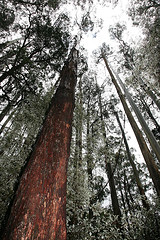
Researchers at The Australian National University have found that a forest in Australia has the world’s greatest amount of carbon storage. After studying biomass carbon density in 132 forests around the world, the University’s research team concluded that a mountain ash forest in the Central Highlands of Victoria is the most carbon-dense forest in the world.
In a June 16 announcement, the University said the results turn prior thinking that tropical rainforests were the most carbon-dense on its head. The study, conducted by Professor Brendan Mackey, Professor David Lindenmayer and Dr. Heather Keith of the Fenner School of Environment and Society at the University, will be published in a United States’ National Academy of Sciences publication.
Professor Mackey said the forest in Victoria is in a moist temperate climate, at the head waters of the Yarra River, surrounded by a national park and state forest. It won out in the analysis because of several factors, such as the rate of plant photosynthesis, growth and decay, he explained. The Central Highlands forest exists at a compromise of these factors, which promote high rates of plant growth but the cooler condition means slower rates of decay, he said.
Furthermore, the trees in the Central Highlands forest are at least 350 years old, he said. Their dense wood allows for more carbon storage. He added that this area has been spared extensive logging activity or other land use.
Another characteristic augmenting the carbon amount in this forest, he explained, pertains to the trees’ ability to endure fire; much of the carbon is in the trunk so an intense fire does not eliminate all of the tree’s carbon. Other Australian forests classed as moist temperate forests also have high carbon density. The researchers found similar forests along the Pacific Coast of North America, Chile and New Zealand have high carbon density as well.

